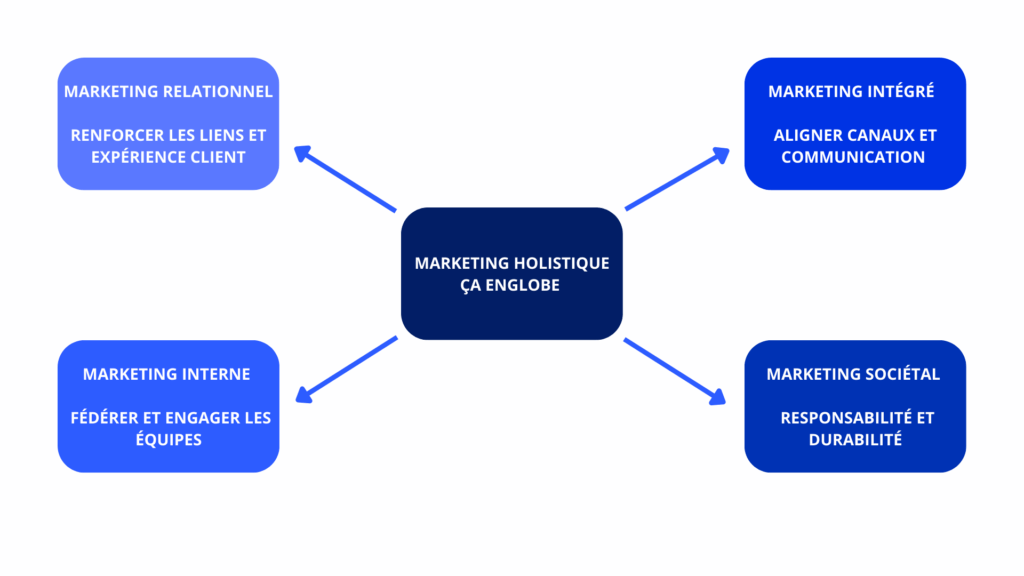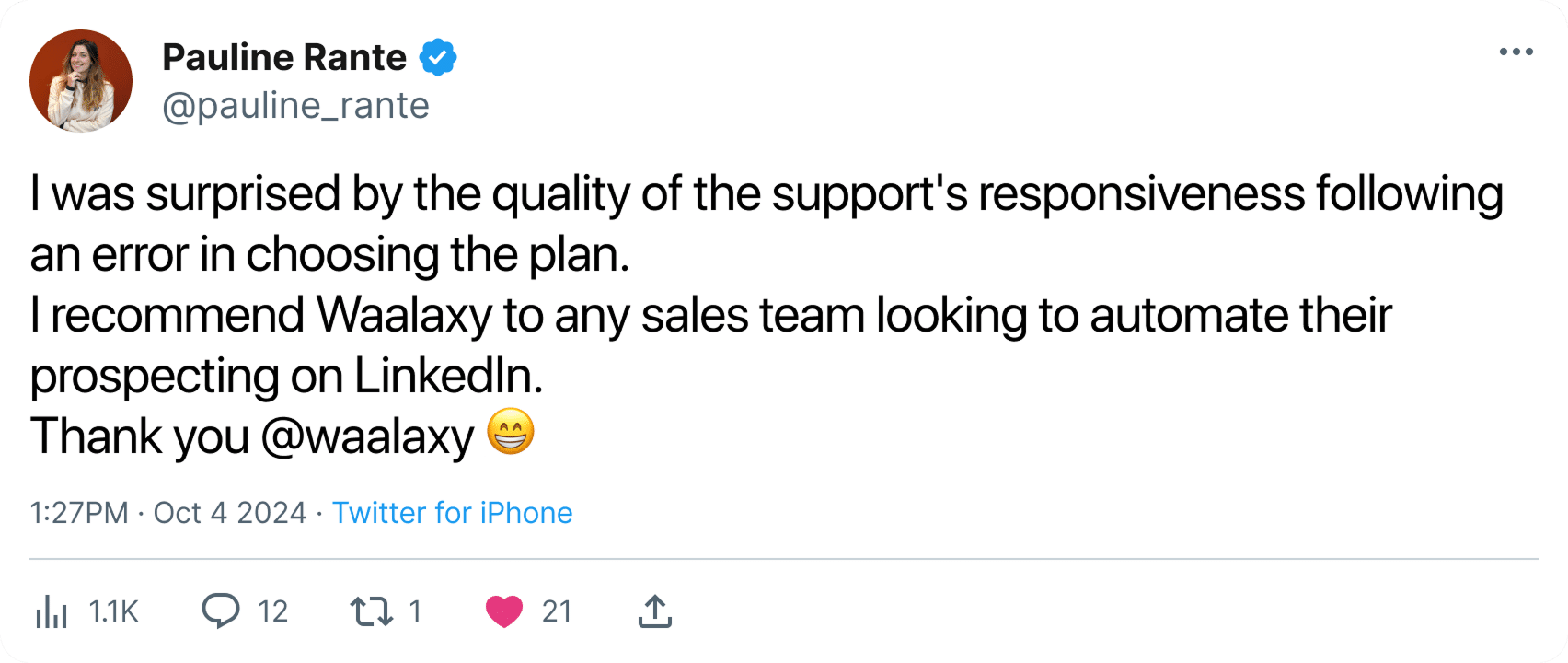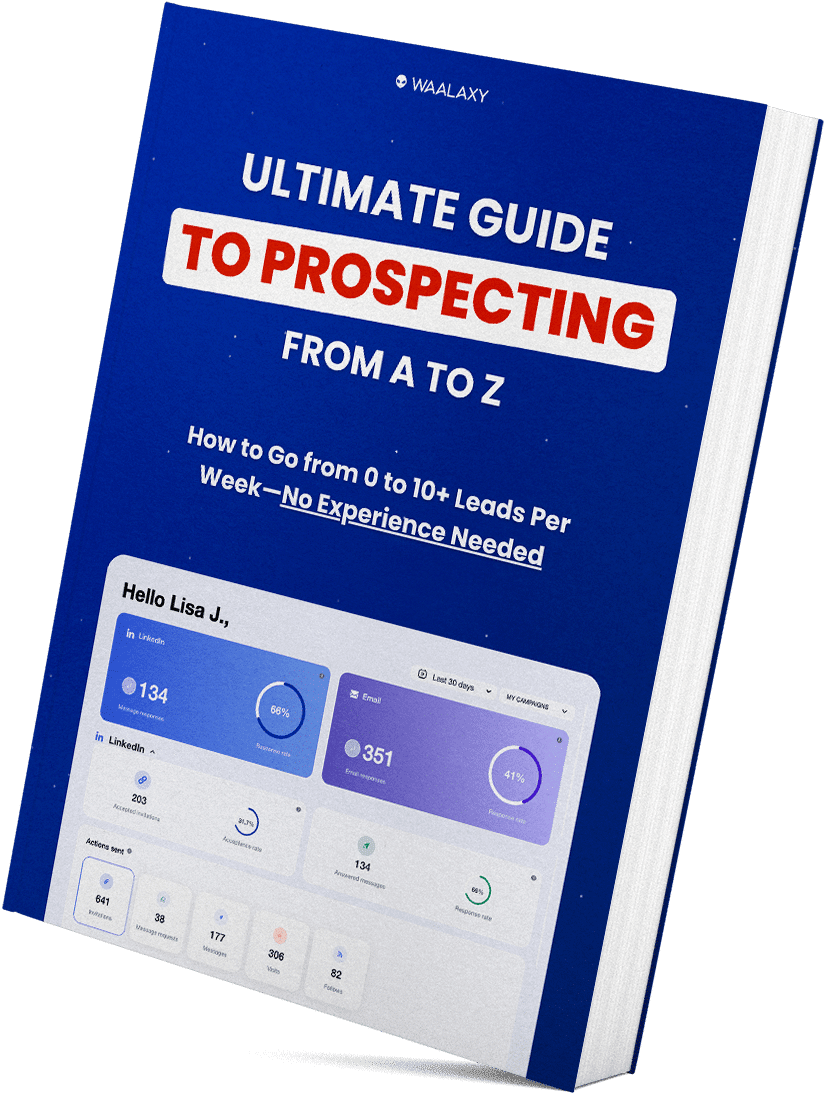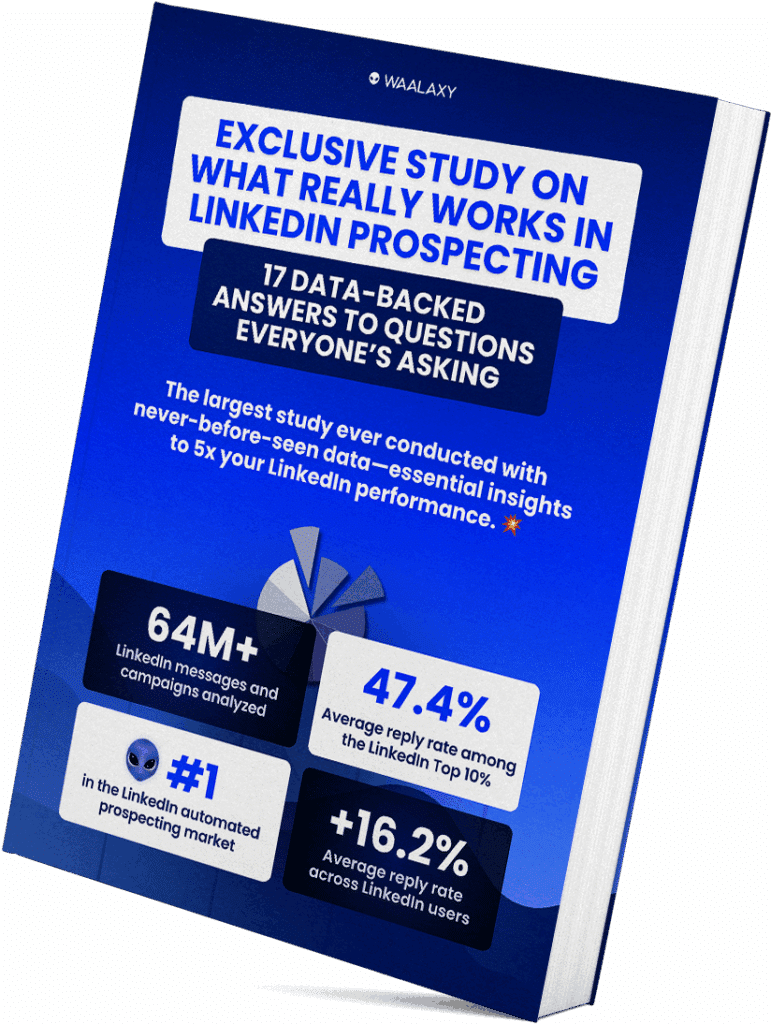You’ve probably heard of digital marketing, omnichannel strategy or 360° communication… But the term holistic marketing often remains vague 🤔. Yet this approach, theorized by Philip Kotler, is becoming a real strategic lever for companies that want to strengthen their brand image, build customer loyalty and align their teams.
In this article, we’ll demystify the holistic marketing concept, see why it’s become a must-have and, above all, how to apply it concretely in your marketing strategy. Ready? 🚀
What is holistic marketing?
Holistic marketing is a bit like moving from a “vision” to a global vision 🔍. Instead of seeing each marketing action as independent, we see them as parts of the same system. 🌍
Holistic marketing is the art of coordinating all your marketing actions to create a seamless, coherent experience.
Rather than launching an email campaign on one side and a LinkedIn ad on the other, with no link between them, the idea is to orchestrate every touchpoint. The objective? To offer your customers a clear, seamless experience , while maximizing the impact of your marketing efforts. ✨
The origins of holistic marketing concept by Philip Kotler
The holistic marketing concept was put forward by Philip Kotler, the “pope of modern marketing” 📚. Back in the 2000s, he explained that marketing could no longer be reduced to simple sales techniques.
For him, a successful company must think of its marketing in a global, integrated way. He defines four holistic marketing dimensions, which are inseparable 👇🏻 :
- 🤝 Relational: Customer relations.
- 🌐 Integrated: Channel coherence.
- 👩🏻💻 Internal: Team commitment.
- 😎 Societal: Impact on society.
In other words: All marketing actions must be coordinated to create sustainable value for the company and its stakeholders.✨
Difference with traditional, 360° or omnichannel marketing
To fully understand the uniqueness of holistic marketing, let’s compare it with other approaches. 👇
| Approach | Key features | Limits | Concrete examples |
|---|---|---|---|
| Traditional marketing | Focused on the product and short-term sales. The objective is to push an offer and trigger a purchase. | Unsuitable for building customer loyalty, as it focuses on the company rather than the customer. | A classic TV ad or a promotional flyer from a supermarket. |
| 360° marketing | Presence on all channels (TV, social networks, press, posters, etc.). The idea is to occupy space everywhere. | Campaigns are often designed channel by channel. There’s a risk of lack of integration and incoherent messages. | A brand that launches a campaign visible on billboards, Insta and TV, but with slightly different slogans. |
| Omnichannel marketing | Smoothes the customer journey between different channels (e.g. starting an order online, then finalizing it in-store). | Limited to the purchasing experience. We don’t touch internal or societal dimensions. | Décathlon, which allows customers to check stock online, reserve and collect in-store. |
| Holistic marketing | Integrates customers, internal teams, partners and societal impact into a unified vision. The aim is to bring coherence with sustainable value. | Requires strong coordination, a solid corporate culture and a long-term vision. | Apple (same store, online and after-sales experience) or Waalaxy (customer relations, internal culture, contribution to startup ecosystem). |
Why take a holistic marketing approach?
Adopting a holistic vision is not just another “buzzword” marketing. It’s a concrete response to today’s challenges: channel saturation, more demanding customers and the need for coherence between your teams.😉
The limits of fragmented marketing
When your marketing channels aren’t connected, you risk cacophony 🎭.
One message on LinkedIn, another in your emails, and a third via your sales reps…your customers receive conflicting signals and lose trust. And for you, it’s a waste of time, money and efficiency 💸.
Marketing in silos creates more confusion than value. 🥲
The benefits of holistic marketing
With a holistic strategic approach, everything aligns and your actions reinforce each other 💪 :
- Consistency: A clear, consistent brand message across all channels.
- Synergy: Your CRM, content marketing, prospecting and automation work together.
- Long-term vision: You’re not just looking to sell, you’re building a solid reputation.
👉 The company gains in efficiency, but above all in lasting impact 🌳.
Today, a customer doesn’t just want to buy a product — they expect a consistent experience 🔄. Holistic marketing helps you create a unified journey that feels seamless, trustworthy and aligned with your values 👇🏻:
- Create a frictionless journey (same tone, same values, everywhere).
- Strengthen loyalty and trust 🤝.
- Enhance your brand image: a brand perceived as consistent and responsible inspires greater credibility.
You’re no longer just marketing, you’re building a lasting relationship with your customers.
The 4 dimensions of holistic marketing
Holistic marketing is based on 4 essential pillars that must work together. These dimensions are not checkboxes ✅, but strategic levers that transform the way you communicate, sell and even work internally.
Relationship marketing: strengthening ties and customer experience
The heart of holistic marketing is the relationship 🤝. We’re not just looking to sell once, but to create a lasting bond. To do this 👇🏻:
- Loyalty and lead nurturing programs (personalized emails, exclusive offers, adapted content).
- Intelligent use of data via CRM and automation to anticipate needs.
- A fluid, consistent experience at every interaction: your customers need to feel that they count.
Holistic marketing example : Waalaxy has built a strong community around its users (LinkedIn, its Supernova media…). The company relies on proximity and support rather than a transactional relationship. The result: customers feel part of an adventure, not just a sales cycle.
Integrated marketing: aligning communications and channels
Everything must speak with one voice 🎤. Why? Because today’s customers don’t discover you via a single channel, but through a series of contact points (social networks, website, word-of-mouth, advertising…). If each interaction sends a different message, you lose credibility and impact. You can set up 👇🏻:
- Harmonized messages across all media.
- An omnichannel strategy where each channel complements the other.
- A consistent brand promise, from website to social networks.
For example: Waalaxy, the brand maintains a unique tone across all its channels: blog, social networks, videos, newsletters. The casual, accessible and “growth-oriented style” can be found everywhere, reinforcing its identity and recognition.
Internal marketing: uniting and engaging teams
You can’t be consistent outwardly if your teams aren’t consistent inwardly 💡. If your employees don’t share the same vision, your customers will feel it immediately. Internal marketing aims to align your teams around a shared mission and values. It’s not just HR communication: it’s a corporate culture that feeds directly into your brand image.
In concrete terms, this means 👇🏻 :
- Collaboration between departments (marketing, sales, product, support).
- Transmission of vision and values to all employees.
- Encouraging creativity and continuous improvement.
For example : at Waalaxy, the company makes a point of cultivating a strong internal culture: autonomy, flexibility, transparency, benevolence. These values are directly reflected in their external communication and in the way teams interact with customers.
Societal marketing: responsibility and sustainability
Holistic marketing isn’t just about winning over customers: it also integrates the company’s role in society 🌍. Today’s consumers expect more than just a good product or service: they want to support brands that have a positive impact. For example, you can set up 👇🏻 :
- A concrete commitment to CSR.
- Transparent communication on its actions and impact.
- Value creation that benefits the community.
For example : Waalaxy , beyond tech, the company actively supports theentrepreneurial and startup ecosystem with free resources, training and educational content. It helps democratize access to digital prospecting, making these practices accessible to small structures and large accounts alike.
Here’s a quick rundown on holistic marketing:

How to implement a holistic marketing strategy?
Moving to holistic marketing requires a real method. There’s no need to reinvent everything at once: it’s all about structuring, connecting and aligning your marketing actions. Here’s a 4-step plan! 👀
Step 1: Audit current marketing practices
You can’t steer without knowing where you stand 🧭. The audit is a bit like doing a complete check-up of your marketing: it reveals your strengths, weaknesses and areas where your actions overlap… or cancel each other out 💸.
👉 What you need to analyze:
- Your channels used: SEO, emailing, social networks, advertising… are they complementary or isolated?
- Message consistency : are your tone, visuals and promise the same everywhere?
- Internal silos: do your teams (marketing, sales, support) share information, or does everyone go their own way?
- Real ROI : does each channel add value, or are you investing at a loss?
A well-executed audit will give you a clear picture of your current marketing and lay the foundations for a coherent, holistic strategy 🌍.
Which tools should you use? Here’s my list 👀 :
| Objective | Tools |
|---|
| Map your channels & processes | Miro, Notion, Trello |
| Analyze your current performance | Google Analytics, HubSpot, Matomo |
| Audit your content & messages | Semrush, Ahrefs, Screaming Frog |
| Measure the effectiveness of ADS campaigns | Google Ads Manager, Meta Ads, LinkedIn Campaign Manager |
Step 2: Define global and transversal KPIs
Holistic marketing can’t be driven by a dozen different Excel spreadsheets 📊. To know whether your strategy is working, you need to track indicators shared by all your teams – not just by channel or department.
The idea is to move away from “each team tracks its own metrics” towards cross-functional KPIs, which reflect the company’s overall performance.
Some examples of really useful KPIs 📈:
- Customer experience: Net Promoter Score (NPS), satisfaction rate, re-purchase rate.
- Campaign consistency: Multi-channel conversion rate, overall engagement (e.g. clicks + interactions on different channels).
- Internal alignment: Employee engagement score, speed of transmission of marketing leads to sales.
- Long-term impact: Brand awareness, recommendation rates, brand perception on social networks.
Step 3: Align prospecting, CRM, content and automation
This is where the magic happens ✨. Holistic marketing is all about connection: your channels, content and tools need to work together, rather than each operating in its own corner.
Without this alignment, you risk :
- Generate leads on the prospecting side that sales doesn’t follow up on properly.
- Publish content that doesn’t feed your sales actions.
- Multiplying tools without coherence, which exhausts your teams 😵.
Start by linking your prospecting campaigns (LinkedIn, email) directly to your CRM. Result: every lead generated is tracked without any loss of information.
Next, make sure your content (articles, webinars, ebooks) actually feeds your sales reps. A prospect who has read a guide or attended a webinar is far more qualified 💡.
To avoid time-consuming follow-ups, set up automation: automatic emails, LinkedIn sequences, personalized nurturing. Your teams save time ⏳ and your prospects are never left out in the cold.
Finally, be sure to synchronize your tools. Any information modified in your CRM should automatically be reflected in your emailing or prospecting campaigns.
Here are the tools I recommend 😉 :
| Lens | Tools | Why use it? |
|---|---|---|
| Multi-channel prospecting | Waalaxy | Centralize your LinkedIn + email campaigns and track results. |
| CRM & team alignment | HubSpot, Pipedrive | Unify marketing & sales data, streamline lead transmission. |
| Automation & nurturing | Make, Zapier | Automate reminders, workflows and synchronize your tools. |
| Content tracking | Notion | Centralize your content and link each resource to sales actions. |
Step 4: Monitor, adjust and continuously improve
Holistic marketing is not a static project: it’s a living process 🔄. Its effectiveness depends on your ability to constantly test, learn and adjust.
👉 Some reflexes to adopt:
- Organize regular reviews of your global KPIs. This allows you to check whether your actions are heading in the right direction.
- Gather customer feedbackto adjust your messages. User feedback is often more valuable than a long report.
- Involve your internal teams in continuous improvement: workshops, debriefs, internal surveys… when your employees participate, they become actors in consistency.
How about a recap on holistic marketing?
Holistic marketing isn’t an abstract concept, it’s a modern and effective way of thinking about your overall strategy 🌍. By coordinating your actions (prospecting, CRM, content, automation), you offer your customers a fluid, consistent experience, while strengthening your brand’s reputation and credibility.
Unlike fragmented marketing, this comprehensive holistique marketing approach aligns your teams and channels in the same direction 🎯. The result: more internal synergy, a clear brand image and more engaged customers 🤝.
By working this way, you reach your target audience more effectively and can optimize every one of your marketing activities, because it’s part of an overall, coherent strategy 👀.
Holistic marketing involves not just communication, but also people, processes and culture — all working together to enhance brand reputation and trust.
The key? Move forward step by step: audit your practices, define cross-functional KPIs, connect your tools and continuously adjust. That’s what turns marketing into a real lever for achieving long-term marketing goals and sustainable growth 🌱.
Frequently asked questions
What’s the difference between holistic marketing and holistic communication?
Holistic communication focuses solely on your messages 🎤 advertising, social networks, branding, press relations… everything must be harmonized to give an impression of coherence. The idea is for your audience to receive the same message, whatever the channel.
But holistic marketing goes much further 🚀. It doesn’t stop at communication:
- It touches on the company’s overall strategy (how you create and deliver value).
- It encompasses customer relations in all their dimensions: acquisition, loyalty, customer satisfaction.
- It also involves the internal experience of employees: an aligned and motivated team naturally conveys a more coherent image.
- It takes into account societal impact 🌍: how your company contributes positively to its environment (CSR, sustainability, social initiatives).
👉 To put it plainly: holistic communication is one brick of holistic marketing, but the latter is a vision of the whole. One aligns your messages, the other aligns the whole company.
What are the key indicators for measuring the success of a holistic strategy?
Measuring your holistic marketing requires looking wider than just click-through rates 👀. Some really telling indicators:
- Internal alignment : are your marketing, sales and support teams working in the same direction (e.g. average time to process a shared lead). This requires a broad vision that goes beyond each department and also integrates internal communications and public relations.
- Overall customer experience: Perceived consistency between your channels and fluidity of the customer journey (e.g.: a customer finds the same promise on LinkedIn, email and in a call). The aim is for all interactions to reflect a single strategy.
- Sustainable value creation: brand reputation, awareness, long-term market share. Here, we’re not just thinking “immediate sales” but shared value with stakeholders (customers, employees, partners, society).
- Societal impact : CSR contribution, ethical perception, community involvement. Holistic marketing takes into account the company’s global role in its environment 🌍.
👉 These KPIs are less “sexy” than short-term ROI, but they show whether your strategy is truly sustainable and coherent ✨.
Now you know all about Holistic Marketing! 🚀









